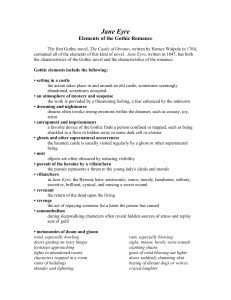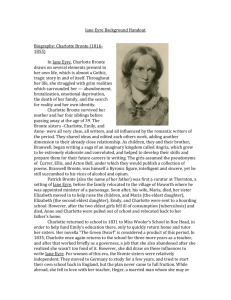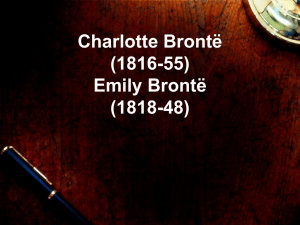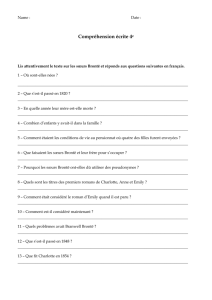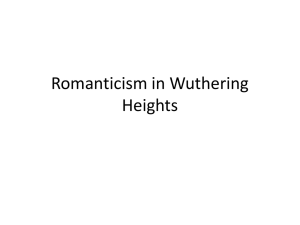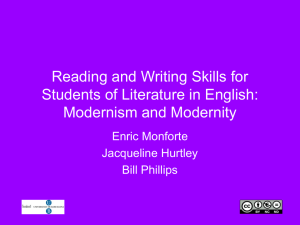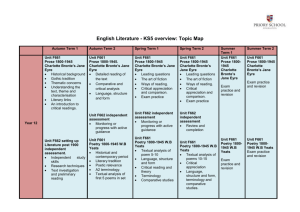As You Read: Make note of the following in Jane Eyre
advertisement
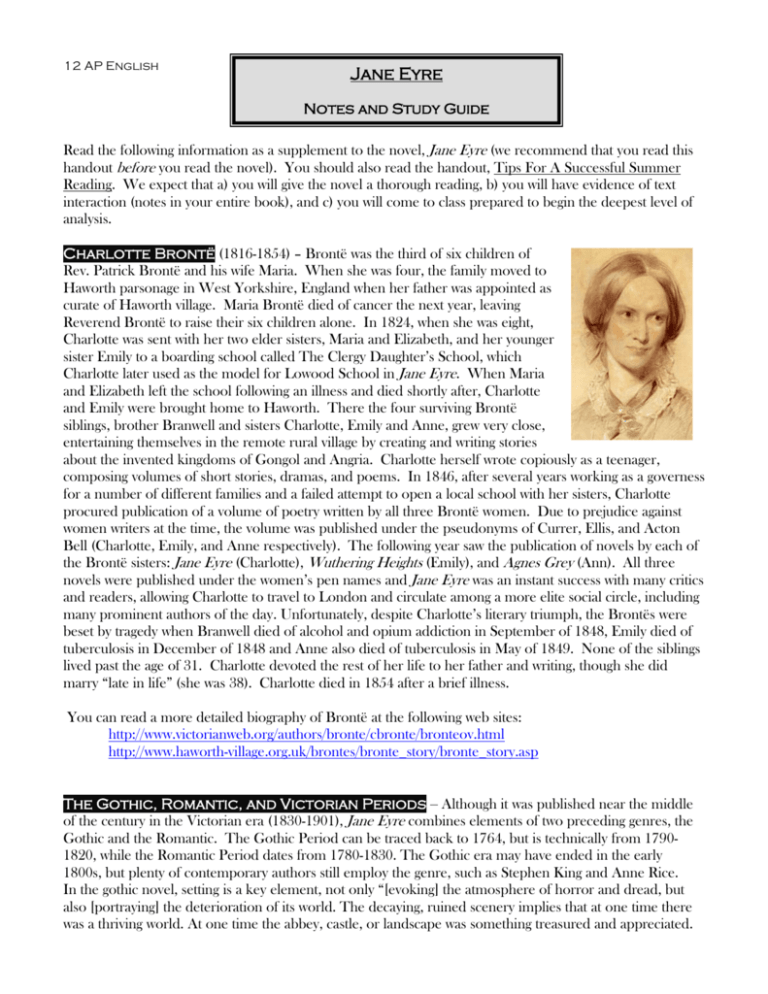
12 AP English Jane Eyre Notes and Study Guide Read the following information as a supplement to the novel, Jane Eyre (we recommend that you read this handout before you read the novel). You should also read the handout, Tips For A Successful Summer Reading. We expect that a) you will give the novel a thorough reading, b) you will have evidence of text interaction (notes in your entire book), and c) you will come to class prepared to begin the deepest level of analysis. Charlotte Brontë (1816-1854) – Brontë was the third of six children of Rev. Patrick Brontë and his wife Maria. When she was four, the family moved to Haworth parsonage in West Yorkshire, England when her father was appointed as curate of Haworth village. Maria Brontë died of cancer the next year, leaving Reverend Brontë to raise their six children alone. In 1824, when she was eight, Charlotte was sent with her two elder sisters, Maria and Elizabeth, and her younger sister Emily to a boarding school called The Clergy Daughter’s School, which Charlotte later used as the model for Lowood School in Jane Eyre. When Maria and Elizabeth left the school following an illness and died shortly after, Charlotte and Emily were brought home to Haworth. There the four surviving Brontë siblings, brother Branwell and sisters Charlotte, Emily and Anne, grew very close, entertaining themselves in the remote rural village by creating and writing stories about the invented kingdoms of Gongol and Angria. Charlotte herself wrote copiously as a teenager, composing volumes of short stories, dramas, and poems. In 1846, after several years working as a governess for a number of different families and a failed attempt to open a local school with her sisters, Charlotte procured publication of a volume of poetry written by all three Brontë women. Due to prejudice against women writers at the time, the volume was published under the pseudonyms of Currer, Ellis, and Acton Bell (Charlotte, Emily, and Anne respectively). The following year saw the publication of novels by each of the Brontë sisters: Jane Eyre (Charlotte), Wuthering Heights (Emily), and Agnes Grey (Ann). All three novels were published under the women’s pen names and Jane Eyre was an instant success with many critics and readers, allowing Charlotte to travel to London and circulate among a more elite social circle, including many prominent authors of the day. Unfortunately, despite Charlotte’s literary triumph, the Brontës were beset by tragedy when Branwell died of alcohol and opium addiction in September of 1848, Emily died of tuberculosis in December of 1848 and Anne also died of tuberculosis in May of 1849. None of the siblings lived past the age of 31. Charlotte devoted the rest of her life to her father and writing, though she did marry “late in life” (she was 38). Charlotte died in 1854 after a brief illness. You can read a more detailed biography of Brontë at the following web sites: http://www.victorianweb.org/authors/bronte/cbronte/bronteov.html http://www.haworth-village.org.uk/brontes/bronte_story/bronte_story.asp The Gothic, Romantic, and Victorian Periods – Although it was published near the middle of the century in the Victorian era (1830-1901), Jane Eyre combines elements of two preceding genres, the Gothic and the Romantic. The Gothic Period can be traced back to 1764, but is technically from 17901820, while the Romantic Period dates from 1780-1830. The Gothic era may have ended in the early 1800s, but plenty of contemporary authors still employ the genre, such as Stephen King and Anne Rice. In the gothic novel, setting is a key element, not only “[evoking] the atmosphere of horror and dread, but also [portraying] the deterioration of its world. The decaying, ruined scenery implies that at one time there was a thriving world. At one time the abbey, castle, or landscape was something treasured and appreciated. Now, all that lasts is the decaying shell of a once thriving dwelling” (http://cai.ucdavis.edu/waterssites/gothicnovel/155breport.html). The hero (or heroine) of the Gothic novel is often isolated, through either self-imposed or compulsory means, and encounters an antagonist who is either implicitly evil or has experienced a fall from grace. In the end the heroine is redeemed through a reunion with a lover or family member. Romantic Love of nature Love of the common man Focus on energy, experimental boldness, creative power, promise, renewal, possibility, imagination, emotion, and freedom, etc. Byronic hero (see below) Famous authors include: William Wordsworth, Samuel Taylor Coleridge, Lord Byron, Percy Bysshe Shelley, John Keats, Ralph Waldo Emerson, Henry David Thoreau Gothic Love of nature Relationship between individual and society Fascination with supernatural (madness, ghosts, spirits, haunted houses, folklore, secrets, etc.) Terror (psychological and physical) Famous authors include: Mary Shelley, Horace Walpole, Daphne du Maurier The Byronic hero – named from Lord Byron’s writing in the 19th century, and one of the most prominent literary character types of the Romantic period. A Byronic hero exhibits several characteristic traits, and in many ways he can be considered a rebel. He does not possess "heroic virtue" in the usual sense; instead, he has many dark qualities. With regard to his intellectual capacity, selfrespect, and hypersensitivity, the Byronic hero is "larger than life," and "with the loss of his titanic passions, his pride, and his certainty of self-identity, he loses also his status as [a traditional] hero." He is usually isolated from society as a wanderer or is in exile of some kind. It does not matter whether this social separation is imposed upon him by some external force or is self-imposed…Often the Byronic hero is moody by nature or passionate about a particular issue. He also has emotional and intellectual capacities, which are superior to the average man. These heightened abilities force the Byronic hero to be arrogant, confident, abnormally sensitive, and extremely conscious of himself…In one form or another, he rejects the values and moral codes of society and because of this he is often unrepentant by society's standards. Often the Byronic hero is characterized by a guilty memory of some unnamed sexual crime. Due to these characteristics, the Byronic hero is often a figure of repulsion, as well as fascination. (http://www.umd.umich.edu/casl/hum/eng/classes/434/charw eb/CHARACTE.htm) Victorian Industrialization and urbanization Relationship between individual and society Scientific and economic progress Colonialism/imperialism Evangelicalism Moral earnestness Gender and social class issues Famous authors include: Charles Dickens; William Thackeray; George Eliot; Anthony Trollope; Thomas Hardy; Alfred, Lord Tennyson As You Read: Make note of the following in Jane Eyre Look at Bronte’s characterization and treatment of women Note the importance of names – consider both people and places Notate Bronte’s symbolic use of nature throughout the novel Consider Bronte’s commentary on the elements of the Romantic, Gothic, and Victorian eras (pay particular attention to role of the individual, gender roles, fascination of the supernatural, and Byronic hero)
